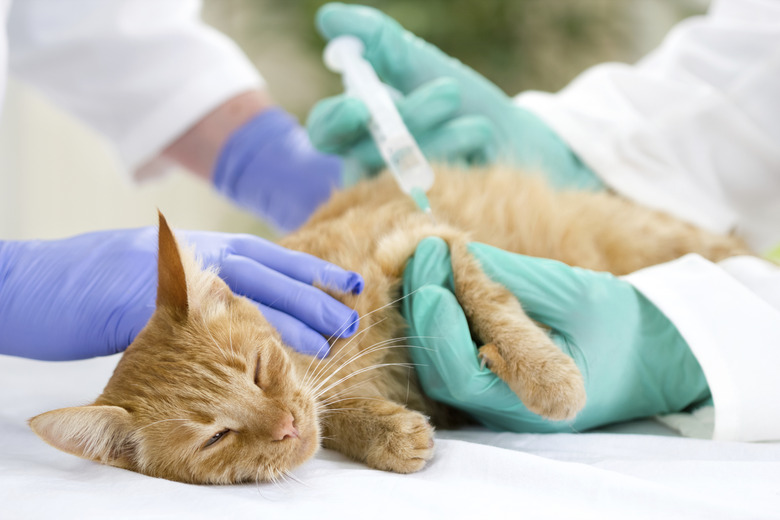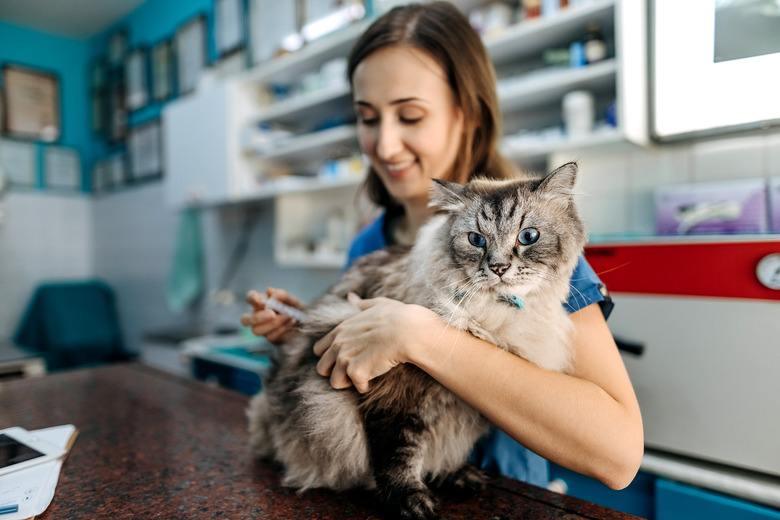Cat Shock Symptoms
Your cat can go into shock as a result of severe illness or physical trauma. Shock is caused by any situation that causes a loss of oxygen in the blood and the restriction of blood flow to your cat's vital organs. If you believe that your cat is in shock or showing any symptoms of shock, take him to the veterinarian immediately.
Cat in shock symptoms: hyperventilation
Cat in shock symptoms: hyperventilation
Unlike dogs, cats do not normally pant or breathe rapidly. when it comes to cat trauma, shock symptoms often include an increased respiratory rate. This can look like your cat is struggling to breathe, panting, or hyperventilating. The normal respiratory rate for a healthy adult cat is between 20 to 30 breaths per minute.
Calculate your cat's breaths per minute by counting the number of breaths he takes within a 15-second period and multiplying it by four. If the number is significantly higher than 30 and your cat has not been engaging in any type of rigorous physical exercise, your cat is probably in shock and hyperventilating. Hyperventilating is a strong sign of a serious medical problem. Take your cat to the veterinarian immediately if he is hyperventilating or showing any other signs of shock.
Cat in shock symptoms: mucous membranes
Cat in shock symptoms: mucous membranes
Your cat's mucous membranes are located in his gums, lips, and inner eyelids. The mucous membranes are normally pink but will appear discolored if your cat is suffering from a medical emergency. If your cat is in shock after a dog attack, trauma, or illness, then his gums may be red, brown, yellow, white, or blue. You can check the color of your cat's gums by lifting his lips up and observing the gums.
Another sign of shock is slow capillary refill time. You can check your cat's capillary refill time by pressing your finger firmly against the gum and holding it there for a second. When you remove your finger from the gum, count how many seconds it takes for the capillary to refill the area with blood and the gum to return to its normal color. The capillaries should take no more than 2 seconds to refill.
Cat in shock symptoms: hypothermia
Cat in shock symptoms: hypothermia
Hypothermia is a fairly common symptom of shock. Hypothermia occurs when your cat's body temperature drops below 99.5 degrees Fahrenheit. The normal body temperature for a cat is between 100.5 and 102.5 degrees Fahrenheit. Symptoms of hypothermia include shivering and being cool to the touch.
Other cat in shock symptoms
Other cat in shock symptoms
Your cat's normal heart rate should be 160 to 240 beats per minute. Shock initially will cause an elevated heart rate but you may see your cat's heart rate and blood pressure drop as the shock progresses into its final stages. The heart rate likely will be inconsistent and irregular as well.
Treating shock in cats
Treating shock in cats
If your cat has suffered a trauma or is displaying symptoms of shock, get him to the vet right away. If you see any obvious bleeding, apply pressure to stop blood loss and consider a muzzle if your cat is lashing out. Consider wrapping him in a towel or blanket while you transport him. This not only keeps your cat from scratching you, it also helps to prevent hypothermia.
The amount of time it takes a cat to recover from shock can vary depending on what caused the shock. In most cases, your veterinarian will administer IV fluids and potentially give a vasopressor medication to help increase blood pressure to normal levels. Additional treatment will depend on the trauma, internal injury, or illness that caused your cat to go into shock.


